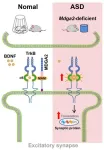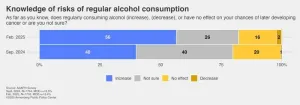(Press-News.org) BOSTON - April 1, 2025 - Most people donning virtual reality (VR) goggles are seeking the thrill of being immersed in a fictitious video game world. But some are donning them for an entirely different experience: to help researchers identify those most at risk of developing Alzheimer’s disease.
“We know that early detection of Alzheimer’s disease and other dementias can have a significant impact on the quality of life of the affected persons, through deployment of lifestyle changes and medications that can slow down disease progression,” says Manu Madhav, a neuroscientist at the University of British Columbia. “However, diagnosis has to be done through collecting biomarkers that are expensive and invasive and thus require sufficient indication of functional impairment.” This leaves opportunity for non-invasive behavioral and cognitive assessments that can give clinicians another tool for early diagnosis – and that’s where VR comes into play.
As will be presented today at the annual conference of the Cognitive Neuroscience Society (CNS) in Boston, Mass., cognitive neuroscientists are increasingly turning to VR technology to develop innovative ways to assess cognitive decline. Their work builds off past research on the role of spatial memory in Alzheimer’s disease but takes the traditional 2-D tasks and transforms them into high-tech, 3-D immersive experiences. New data is finding significant age-related and disease-related differences in how individuals can navigate and locate objects within a VR space, in some cases linking cognitive impairments to build up of Alzheimer’s proteins in the brain.
Exploring spatial memory and navigation
About 1 in 13 people between the ages of 65 and 84 will develop Alzheimer’s disease, according to the National Institute on Aging, and that number is projected to rise as life expectancy increases. But for cognitive neuroscientist Tammy Tran, studying memory and Alzheimer's disease is about more than statistics. Like so many people, she has had loved ones develop memory disorders, and after reading Oliver Sacks’ The Man Who Mistook his Wife for a Hat as a teenager, her fascination with memory really took off.
“Episodic memory is so fascinating to me because your experiences and memories shape and define you as an individual,” says Tran of Stanford University, who is chairing a symposium on VR and memory at the CNS meeting. “What happens when you forget and lose those experiences?”
Tran will be presenting new, pre-press work, led by Hadi Hosseini (Stanford), that shows how VR-based memory assessments can be used in combination with biofluid biomarkers of Alzheimer's to predict who might be at risk of developing the disease. Working with young adults, clinically unimpaired older adults, and patients with mild cognitive impairment (often a precursor to Alzheimer’s), her team asked participants to remember the location of different objects, such as a TV remote or glasses, within a VR living room. They were also asked to recreate the living room environment in a later task.
“We found decreased object location memory, as well as decreased precision for the object location memory, between young adults and older adults and unimpaired participants and those with mild cognitive impairment,” she says.
To better contextualize these assessments, they worked with neurologists to collect Alzheimer’s disease biofluid biomarkers, specifically plasma Aβ42/Aβ40 and pTau217 from the older adult participants. “We found that pTau217 predicted both object location memory and location precision performance across our sample,” Tran says. “These findings indicate that across both clinically unimpaired older adults and patients with mild cognitive impairment, presence of Alzheimer’s proteins significantly impacts memory performance.”
This work is consistent with an emerging research that indicates that the presence of Alzheimer’s proteins impact memory function in subtle but detectable ways before the onset of clinical symptoms. Linking these Alzheimer’s disease biomarkers to cognitive function using immersive VR is something that would have been unimaginable even 5 years ago, Tran says. That’s because of research made possible by NIH funding, as well as the work of advocacy of organizations like the Alzheimer’s Association, that has transformed diagnosis of the disease – moving from post-mortem biomarker analysis, to imaging, and then cerebrospinal fluid, biomarkers, to collecting proteins from blood plasma.
The work is also exciting in how it has transformed an entertainment technology for clinical uses. “I’ve been working in the Alzheimer's field for about 10 years, and I have never seen such excitement from participants when they’re doing an experiment,” Tran says. “For many people, this is their first experience with immersive virtual reality but since the movement is meant to mimic real-life, it is remarkably easy for them to pick up an item, walk around the room, and interact with the virtual world.”
The innovative use of VR technology in cognitive neuroscience is what attracted Manu Madhav to the research. An engineer and roboticist by training, he was fascinated by the parallels between the way robots process and integrate sensory information, and the way human brains evolved to do the same. After working on spatial navigation in rodents, he had the opportunity to collaborate with a center for Alzheimer's disease to develop VR methods for measuring spatial navigation impairments in Alzheimer’s patients.
“Engineering VR to be comfortable and intuitive for older participants has been the greatest challenge,” he says. “We managed to find small but significant improvements that nevertheless have made it possible to place older participants in an immersive VR environment for over an hour with minimal concerns of nausea or disorientation.” These VR systems integrate sensors for head and eye tracking, as well as controllers that can allow for rich and expressive input.
Madhav’s team’s work is now in the early phase, working with healthy older adults and young adults but has already shown promise. They asked participants to navigate a series of corridors in a VR space while keeping track of their starting location and the locations of periodically hidden landmarks.
“We have found that healthy younger and older adults differ in their navigational abilities, setting the stage for our recruitment of participants with early Alzheimer’s disease scheduled to begin this year,” he explains. “We expect that the presence of different complexity levels across trials will amplify differences between younger and older participants, and between older participants and those diagnosed with early Alzheimer’s disease.”
Madhav sees VR as an exciting tool not only for understanding and diagnosing Alzheimer’s disease but also for exploring other cognitive questions and disorders. “The recent, unprecedented increase in accessibility to VR systems should allow for cognitive neuroscience labs with comparatively less expertise to jump into the space and leverage VR to answer complex cognitive questions that require immersion and multimodal feedback.”
–
The symposium “Harnessing virtual reality to study memory and spatial navigation across the lifespan” is taking place at 1:30pmEDT on Tuesday. April 1, as part of the CNS 2025 annual meeting from March 29-April 1, in Boston.
CNS is committed to the development of mind and brain research aimed at investigating the psychological, computational, and neuroscientific bases of cognition. Since its founding in 1994, the Society has been dedicated to bringing its 2,000 members worldwide the latest research to facilitate public, professional, and scientific discourse.
END
How VR technology is changing the game for Alzheimer’s disease
CNS 2025
2025-04-01
ELSE PRESS RELEASES FROM THIS DATE:
A borrowed bacterial gene allowed some marine diatoms to live on a seaweed diet
2025-04-01
A group of diatom species belonging to the Nitzschia genus, gave up on photosynthesis and now get their carbon straight from their environment, thanks to a bacterial gene picked up by an ancestor. Gregory Jedd of Temasek Life Sciences Laboratory, Singapore, and colleagues report these findings in a new study published April 1st in the open-access journal PLOS Biology.
Unlike most diatoms, which perform photosynthesis to generate carbon compounds, some members of the genus Nitzschia have no chlorophyll and instead ...
Balance between two competing nerve proteins deters symptoms of autism in mice
2025-04-01
In mice, autism symptoms arise when a certain pair of competing nerve proteins falls out of equilibrium, according to a study published April 1st in the open-access journal PLOS Biology by Dongdong Zhao of Wenzhou Medical University, China, Yun-wu Zhang of Xiamen University, China, and colleagues.
Approximately 1% of the world population is considered to have Autism Spectrum Disorder (ASD), exhibiting a series of social and cognitive symptoms. Previous research has linked certain genetic factors to ASD, including many associated ...
Use of antifungals in agriculture may increase resistance in an infectious yeast
2025-04-01
Genomic changes in the infectious yeast Candida tropicalis may play a role in its resistance to antifungals, according to a study published on April 1st in the open-access journal, PLOS Biology by Guanghua Huang at Fudan University, China, and colleagues. These genomic changes can be brought on by a common antifungal, TBZ. The study demonstrates that the use of TBZ in agriculture may contribute to the increasing problem of antifungal resistance.
C. tropicalis is one of the most common fungi to infect humans, ...
Awareness grows of cancer risk from alcohol consumption, survey finds
2025-04-01
PHILADELPHIA – Public awareness of the link between drinking alcohol and an elevated risk of cancer has grown since last fall, with more than half of Americans now saying that regularly consuming alcohol increases your chances of later developing cancer, according to a survey by the Annenberg Public Policy Center (APPC) of the University of Pennsylvania.
In the survey, conducted Jan. 30-Feb. 10, 2025, with over 1,700 U.S. adults, 56% say the regular consumption of alcohol increases your chances of later developing cancer, up from 40% in an Annenberg survey in September 2024. The percentage of those who say alcohol ...
The experts that can outsmart optical illusions
2025-04-01
Medical imaging experts are adept at solving common optical illusions, according to research from four UK universities, including the University of East Anglia.
The correct analysis of medical images from scans, such as MRI, is critical for diagnosing cancer and many other conditions.
A new study published today shows that people who do this professionally are also more accurate at judging the size of objects in common optical illusions.
In other words, medical imaging experts also literally see better in everyday life!
The research is also the ...
Pregnancy may reduce long COVID risk
2025-04-01
Pregnancy may offer some protection from developing Long COVID, found a new study led by Weill Cornell Medicine, University of Rochester Medical Center, University of Utah Health and Louisiana Public Health Institute. Previous research has mostly focused on non-pregnant adults affected by Long COVID— a condition lasting for months after a person recovers from SARS-CoV-2 infection.
The study, published April 1 in Nature Communications, helps fill a critical gap about Long COVID in women infected with SARS-CoV-2 ...
Scientists uncover novel immune mechanism in wheat tandem kinase
2025-04-01
Wheat is grown over more land area than any other food crop. Among pathogen-driven threats to wheat, fungi top the list, causing billions of dollars of losses each year and posing a serious challenge to food security worldwide.
In an effort to combat this problem, a research team led by Prof. LIU Zhiyong from the Institute of Genetics and Developmental Biology of the Chinese Academy of Sciences, together with collaborators, has uncovered a novel immune mechanism by which tandem kinase proteins (TKPs) combat pathogen invasion in wheat.
TKPs are a recently discovered class of disease resistance proteins in wheat and barley. Characterized by two or more tandemly arranged ...
Three University of Virginia Engineering faculty elected as AAAS Fellows
2025-04-01
Faculty representing three disciplines in the University of Virginia School of Engineering and Applied Science — computer science, mechanical and aerospace engineering, and civil and environmental engineering — have been elected to the rank of fellow by the American Association for the Advancement of Science.
The AAAS is one of the world’s largest general scientific societies and publisher of the Science family of journals. UVA Engineering’s faculty are among 471 scientists and engineers named in the class of 2024, according to the AAAS.
Fellows are selected ...
Unintentional drug overdoses take a toll across the U.S. unequally, study finds
2025-04-01
A recent study from Columbia University’s Mailman School of Public Health reveals significant racial and sex disparities in drug overdose mortality rates. The research found that both Black men and Black women have been disproportionately impacted by overdose deaths, with their mortality rates rising sharply compared to their White counterparts. This study expands scientific understanding of how race, sex, and regional factors intersect to affect overdose outcomes. The study's findings are published ...
A step toward plant-based gelatin
2025-04-01
WASHINGTON, April 1, 2025 – With increased awareness about food sources and their environmental impacts, replacing animal-derived products in food and drugs is a significant research area. One common — but often overlooked — animal protein is gelatin, found everywhere from candy to plastic-free packaging.
In Physics of Fluids, by AIP Publishing, researchers from the University of Ottawa present gum tragacanth as a plant-based alternative to gelatin for creating edible films.
“Gelatin has ...
LAST 30 PRESS RELEASES:
Sports injuries sustained during your period might be more severe
World's first successful 2 Tbit/s free-space optical communication using small optical terminals mountable on satellites and HAPS
Can intimate relationships affect your heart? New study says ‘yes’
Scalable and healable gradient textiles for multi‑scenario radiative cooling via bicomponent blow spinning
Research shows informed traders never let a good climate crisis go to waste
Intelligent XGBoost framework enhances asphalt pavement skid resistance assessment
Dual-function biomaterials for postoperative osteosarcoma: Tumor suppression and bone regeneration
New framework reveals where transport emissions concentrate in Singapore
NTP-enhanced lattice oxygen activation in Ce-Co catalysts for low-temperature soot combustion
Synergistic interface engineering in Cu-Zn-Ce catalysts for efficient CO2 hydrogenation to methanol
COVID-19 leaves a lasting mark on the human brain
Scientists use ultrasound to soften and treat cancer tumors without damaging healthy tissue
Community swimming program for Black youth boosts skills, sense of belonging, study finds
Specific depressive symptoms in midlife linked to increased dementia risk
An ‘illuminating’ design sheds light on cholesterol
Who is more likely to get long COVID?
Study showcases resilience and rapid growth of “living rocks”
Naval Research Lab diver earns Office of Naval Research 2025 Sailor of the Year
New Mayo-led study establishes practical definition for rapidly progressive dementia
Fossil fuel industry’s “climate false solutions” reinforce its power and aggravate environmental injustice
Researchers reveal bias in a widely used measure of algorithm performance
Alcohol causes cancer. A study from IOCB Prague confirms damage to DNA and shows how cells defend against it
Hidden viruses in wastewater treatment may shape public health risks, study finds
Unlock the power of nature: how biomass can transform climate mitigation
Biochar reshapes hidden soil microbes that capture carbon dioxide in farmland
Reducing saturated fat intake shows mortality benefit, but only in high-risk individuals
Manta rays create mobile ecosystems, study finds
Study: Mixed results in using lipoic acid to treat progressive multiple sclerosis
Norbert Holtkamp appointed director of Fermi National Accelerator Laboratory
New agentic AI platform accelerates advanced optics design
[Press-News.org] How VR technology is changing the game for Alzheimer’s diseaseCNS 2025






